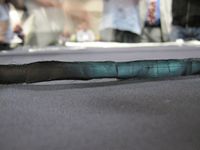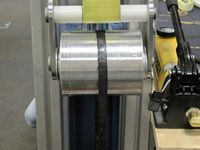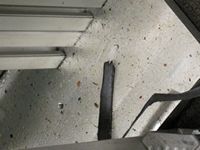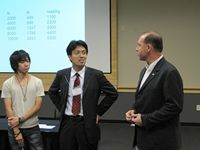 Well, the 2009 Tether Competition, one of the two Space Elevator Games, is over and it was a) very educational and b) a lot of fun.
Well, the 2009 Tether Competition, one of the two Space Elevator Games, is over and it was a) very educational and b) a lot of fun.
Only 1 team competed, an entrant from Shizuoka, Japan. They brought a carbon nanotube tether with them to a) compete against the ‘House Tether’ (the first hurdle) and, if they succeeded, to then try and beat the 5 M-Yuri mark which would make them eligible to win the NASA-donated prizes.
 Alas, they did not succeed in beating the House Tether, so they did not qualify to try for the prize money. But they did a very important thing; they showed up and they showed up with a carbon nanotube tether.
Alas, they did not succeed in beating the House Tether, so they did not qualify to try for the prize money. But they did a very important thing; they showed up and they showed up with a carbon nanotube tether.
I don’t have the exact numbers of when/where their tether broke. Ben Shelef (CEO of the Spaceward Foundation – the group that organizers the Space Elevator Games) had developed a table of this for a 2 meter, 2 gram tether. The Japanese brought a tether which was both longer and lighter than required. This put them at a serious disadvantage. When Ben calculates the exact ‘strength numbers’, I’m sure he’ll put them on the official website of the Space Elevator Games, www.spaceelevatorgames.org.
 The tether the Japanese brought was very different from other tethers we’ve seen, it looked like VCR tape – other tethers (especially competition tethers) look like thin ropes.
The tether the Japanese brought was very different from other tethers we’ve seen, it looked like VCR tape – other tethers (especially competition tethers) look like thin ropes.
The nanotubes in their tether were not spun together, they were held together strictly and solely by Van Der Waals force. The reason they did this was their belief that spinning the nanotube strands ultimately weakens them. I’m not qualified to speak to that, but time will tell if their approach is superior or not. They are going to try and use covalent bonding forces (it’s been a long time since High School chemistry) to strengthen their nanotube product.
 I’ve included some more pictures in this post – pictures are always interesting 🙂
I’ve included some more pictures in this post – pictures are always interesting 🙂
The topmost picture is a side view of the Japanese tether – as you can see, it looks like a tape from an old VCR Cassette.
The second picture is of this tether after it has been mounted on the “Torture Tether Rack”.
 The third picture shows the Rack with the Japanese tether and the “House tether” mounted, side by side. On the left is the House tether and on right is the Japanese tether. As you can see, the Japanese tether is quite a bit longer.
The third picture shows the Rack with the Japanese tether and the “House tether” mounted, side by side. On the left is the House tether and on right is the Japanese tether. As you can see, the Japanese tether is quite a bit longer.
The fourth picture shows the Japanese tether after it broke -you can see the end of it laying against the bottom of the Rack.
The last picture is of the Japanese team (Yoku Inoue is in the middle) being congratulated by Andy Petro (on the right), the head of the NASA IPP (Innovative Partner Program). Andy thanked the team for coming and gave them both NASA Pins to commemorate the event.
I’m sure the Japanese will be back next year, and this time with a year’s experience under their figurative belt – they will be much, much, better…
(Click on any of the picture thumbnails to see a larger version of the picture)

Thanks for this coverage, Ted. You’re right; the pictures are what really drew me. 🙂
Sorry to hear that the test was over so quickly. Did the team have access to a test rig (including the house tether) before they arrived, or at least the specs for creating one? That might help teams avoid some of the basic sizing problems they had.
Charles, the full specs are available at http://www.spaceward.org/elevator2010-ts (and have been for quite some time).
It’s up to the competitors to make their own test rig – they know what the requirements are for the tether.
Instead of trying to make a strong tether…..how about NOT tying one end to EARTH and just reeling in the load to geosynchronus orbit?
Pingback: Space elevator looks both closer and farther away - SmartPlanet
Hurry up and build a space elevator or stop talking about how to build one. DO IT ALREADY!!!!
Pingback: Space elevator faces reality | Ethiopian News
Michael Bush wrote:
Instead of trying to make a strong tether…..how about NOT tying one end to EARTH and just reeling in the load to geosynchronus orbit?
This is a really good question. The trouble is that the strain on the ribbon doesn’t come from bolting it to the earth. The strain comes from the weight of the ribbon itself. The ribbon has to be strong enough to support its own weight between GEO and earth, plus the weight of the climber. It also has to be light enough to be launched into orbit at reasonable cost.
Have you ever tried making a rope out of silly putty? If you hold a silly putty rope by one end it can keep it’s form if it is short enough and thick enough to support it’s own weight. If it is too long and too skinny, it will stretch and snap under it’s own weight.
So why don’t they just make the ribbon thicker at the top? Well, they actually are considering a taper, but the taper could easily be too much. The ribbon is tens of thousands of miles long. A taper would require the thickness to increase exponentially as you went higher. If the ribbon were only the thickness of a hair on the surface of the earth, it could be so massive at GEO that you would never recover the cost of launching it into orbit.
is there a link to Yoku Inoue or the team from from Shizuoka, Japan? (it’s a good practice to mention the team members at the beginning of the article / post).
From the leader of Team Astroaraneae, good effort University of Shizuoka!! It is a little late, but I had not heard of the competition until now…
What happened to Brad Edwards? In 2007, he had suggested he had a material with which he would compete in 2008?
Team Astroaraneae members had enjoyed being the competitor with the strongest tether in the 2006 and 2007 Tether Challenge, in addition to besting Centaurus Aerospace’s results in 2005.
For a cool Tether competition documentary check out ‘The Mighty Tether’!!
Carbon Nanotubes are usually portrayed as a simple tether connecting one point to another. A pathway for the climber. Carbon nanotubes are good conductors but we only see ‘power beams – lasers’ used to get the power to the climber. Why can’t nanotubes be used as a wire to conduct electricity to the climbers?
Also – given the tremendous potential differences between Earth (ground) and Space – could the elevator itself be a power source?
Pingback: JPSEC 2009 Updates from US and Europe « JSEA Activities
Pingback: Happy New Year! - The Space Elevator Blog
@DanielArmstrong: Ive always wondered that myself… if carbon nanotubes are such good conductors, why use a laser to power the elevators?
Rogério Penna
Novo Hamburgo-RS/Brazil
Pingback: 3rd JpSEC conference - JpSEC ‘10 - The Space Elevator Blog
Pingback: New items from Japan - The Space Elevator Blog